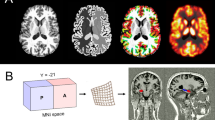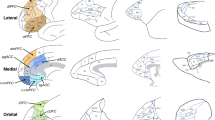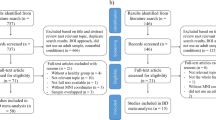Abstract
Major depression is a heterogeneous condition, and the search for neural correlates specific to clinically defined subtypes has been inconclusive. Theoretical considerations implicate frontostriatal, particularly subgenual prefrontal cortex (PFC), dysfunction in the pathophysiology of melancholia—a subtype of depression characterized by anhedonia—but no empirical evidence has been found yet for such a link. To test the hypothesis that melancholic, but not nonmelancholic depression, is associated with the subgenual PFC impairment, concurrent measurement of brain electrical (electroencephalogram, EEG) and metabolic (positron emission tomography, PET) activity were obtained in 38 unmedicated subjects with DSM-IV major depressive disorder (20 melancholic, 18 nonmelancholic subjects), and 18 comparison subjects. EEG data were analyzed with a tomographic source localization method that computed the cortical three-dimensional distribution of current density for standard frequency bands, allowing voxelwise correlations between the EEG and PET data. Voxel-based morphometry analyses of structural magnetic resonance imaging (MRI) data were performed to assess potential structural abnormalities in melancholia. Melancholia was associated with reduced activity in the subgenual PFC (Brodmann area 25), manifested by increased inhibitory delta activity (1.5–6.0 Hz) and decreased glucose metabolism, which themselves were inversely correlated. Following antidepressant treatment, depressed subjects with the largest reductions in depression severity showed the lowest post-treatment subgenual PFC delta activity. Analyses of structural MRI revealed no group differences in the subgenual PFC, but in melancholic subjects, a negative correlation between gray matter density and age emerged. Based on preclinical evidence, we suggest that subgenual PFC dysfunction in melancholia may be associated with blunted hedonic response and exaggerated stress responsiveness.
This is a preview of subscription content, access via your institution
Access options
Subscribe to this journal
Receive 12 print issues and online access
$259.00 per year
only $21.58 per issue
Buy this article
- Purchase on Springer Link
- Instant access to full article PDF
Prices may be subject to local taxes which are calculated during checkout




Similar content being viewed by others
References
Davidson RJ, Pizzagalli D, Nitschke JB, Putnam K . Depression: perspectives from affective neuroscience. Annu Rev Psychol 2002; 53: 545–574.
Drevets WC . Neuroimaging and neuropathological studies of depression: implications for the cognitive–emotional features of mood disorders. Curr Opin Neurobiol 2001; 11: 240–249.
Parker G, Hadzi-Pavlovic D, Austin MP, Mitchell P, Wilhelm K, Hickie I et al. Sub-typing depression, I. Is psychomotor disturbance necessary and sufficient to the definition of melancholia? Psychol Med 1995; 25: 815–823.
Rush AJ, Weissenburger JE . Melancholic symptom features and DSM-IV. Am J Psychiatry 1994; 151: 489–498.
Rogers MA, Bradshaw JL, Pantelis C, Phillips JG . Frontostriatal deficits in unipolar major depression. Brain Res Bull 1998; 47: 297–310.
Austin MP, Mitchell P . The anatomy of melancholia: does frontal–subcortical pathophysiology underpin its psychomotor and cognitive manifestations? Psychol Med 1995; 25: 665–672.
Wise RA, Rompre PP . Brain dopamine and reward. Annu Rev Psychol 1989; 40: 191–225.
Drevets WC, Price JL, Simpson JRJ, Todd RD, Reich T, Vannier M et al. Subgenual prefrontal cortex abnormalities in mood disorders. Nature 1997; 386: 824–827.
Hirayasu Y, Shenton ME, Salisbury DF, Kwon JS, Wible CG, Fischer IA et al. Subgenual cingulate cortex volume in first-episode psychosis. Am J Psychiatry 1999; 156: 1091–1093.
Öngür D, Drevets WC, Price JL . Glial reduction in the subgenual prefrontal cortex in mood disorders. Proc Natl Acad Sci USA 1998; 95: 13290–13295.
Bremner JD, Vythilingam M, Vermetten E, Nazeer A, Adil J, Khan S et al. Reduced volume of orbitofrontal cortex in major depression. Biol Psychiatry 2002; 51: 273–279.
Brambilla P, Nicoletti MA, Harenski K, Sassi RB, Mallinger AG, Frank E et al. Anatomical MRI study of subgenual prefrontal cortex in bipolar and unipolar subjects. Neuropsychopharmacology 2002; 27: 792–799.
Gaspar P, Berger B, Febvret A, Vigny A, Henry JP . Catecholamine innervation of the human cerebral cortex as revealed by comparative immunohistochemistry of tyrosine hydroxylase and dopamine-beta-hydroxylase. J Comp Neurol 1989; 279: 249–271.
Drevets WC, Öngür D, Price JL . Neuroimaging abnormalities in the subgenual prefrontal cortex: implications for the pathophysiology of familial mood disorders. Mol Psychiatry 1998; 3: 220–226.
Pizzagalli D, Pascual-Marqui RD, Nitschke JB, Oakes TR, Larson CL, Abercrombie HC et al. Anterior cingulate activity as a predictor of degree of treatment response in major depression: evidence from brain electrical tomography analysis. Am J Psychiatry 2001; 158: 405–415.
American Psychiatric Association. Diagnostic and Statistical Manual of Mental Disorders, 4th edn. American Psychiatric Association: Washington, DC, 1994.
Spitzer RL, Williams JBW, Gibbon M, First MB . Structured Clinical Interview for DSM-III-R. American Psychiatric Press: Washington, DC, 1992.
Hollingshead AB . Two Factor Index of Social Position. Yale University: New Haven, CT, 1957.
Hamilton M . A rating scale for depression. J Neurol Neurosurg Psychiatry 1960; 23: 56–62.
Beck AT, Ward CH, Medleson M, Mock J, Erbaugh J . An inventory for measuring depression. Arch Gen Psychiatry 1961; 4: 561–571.
Abercrombie HC, Schaefer SM, Larson CL, Oakes TR, Holden JE, Perlman SB et al. Metabolic rate in the right amygdala predicts negative affect in depressed patients. Neuroreport 1998; 9: 3301–3307.
Brillinger DR . Time Data Analysis and Theory. McGraw-Hill: New York, 1981.
Pascual-Marqui RD, Michel CM, Lehmann D . Low resolution electromagnetic tomography: a new method for localizing electrical activity in the brain. Int J Psychophysiol 1994; 18: 49–65.
Pascual-Marqui RD, Lehmann D, Koenig T, Kochi K, Merlo MC, Hell D et al. Low resolution brain electromagnetic tomography (LORETA) functional imaging in acute, neuroleptic-naive, first-episode, productive schizophrenia. Psychiatry Res: Neuroimaging 1999; 90: 169–179.
Pizzagalli DA, Nitschke JB, Pascual-Marqui RD, Larson CL, Abercrombie HC, Schaefer SM et al. Brain electrical tomography abnormalities in depression: the importance of melancholic features and anxiety. Biol Psychiatry 2002; 52: 73–85.
Ary JP, Klein SA, Fender DH . Location of sources of evoked scalp potentials: corrections for skull and scalp thicknesses. IEEE Trans Biomed Eng 1981; 28: 447–452.
Towle VL, Bolanos J, Suarez D, Tan K, Grzeszczuk R, Levin DN et al. The spatial location of EEG electrodes: locating the best-fitting sphere relative to cortical anatomy. Electroencephalogr Clin Neurophysiol 1993; 86: 1–6.
Evans AC, Collins DL, Mills SR, Brown ED, Kelly RL, Peters TM . 3D statistical neuroanatomical models from 305 MRI volumes. Proc IEEE Nucl Sci Symp Med Imag Conf 1993; 95: 1813–1817.
Collins DL, Neelin P, Peters TM, Evans AC . Automatic 3D intersubject registration of MR volumetric data in standardized Talairach space. J Comput Assist Tomogr 1994; 18: 192–205.
Lancaster JL, Rainey LH, Summerlin JL, Freitas CS, Fox PT, Evans AC et al. Automated labeling of the human brain—a preliminary report on the development and evaluation of a forward-transformed method. Hum Brain Mapp 1997; 5: 238–242.
Talairach J, Tournoux P . Co-planar Stereotaxic Atlas of the Human Brain. Thieme Medical Publishers, Inc.: New York, 1988.
Brett M, Johnsrude IS, Owen AM . The problem of functional localization in the human brain. Nat Rev Neurosci 2002; 3: 243–249.
Phelps ME, Huang SC, Hoffman EJ, Selin C, Sokoloff L, Kuhl DE . Tomographic measurement of local cerebral glucose metabolic rate in humans with (F-18)2-fluoro-2-deoxy-D-glucose: validation of method. Ann Neurol 1979; 6: 371–388.
Friston KJ, Worsley KJ, Frackowiak RSJ, Mazziotta JC, Evans AC . Assessing the significance of focal activations using their spatial extent. Hum Brain Mapp 1994; 1: 214–220.
Oakes TR, Pizzagalli D, Hendrick AM, Horras KA, Larson CL, Abercrombie HC et al. Functional coupling of simultaneous electrical and metabolic activity in the human brain. Hum Brain Mapp. (in press).
Ashburner J, Friston KJ . Voxel-based morphometry—the methods. Neuroimage 2000; 11: 805–821.
Ashburner J, Friston KJ . Nonlinear spatial normalization using basis functions. Hum Brain Mapp 1999; 7: 805–821.
Dunn RT, Kimbrell TA, Ketter TA, Frye MA, Willis MW, Luckenbaugh DA et al. Principal components of the Beck Depression Inventory and regional cerebral metabolism in unipolar and bipolar depression. Biol Psychiatry 2002; 51: 387–399.
Cohen J . Statistical Power Analysis for the Behavioral Sciences. Erlbaum Associates: Hillsdale, NJ, 1988.
Volkow ND, Logan J, Fowler JS, Wang GJ, Gur RC, Wong C et al. Association between age-related decline in brain dopamine activity and impairment in frontal and cingulate metabolism. Am J Psychiatry 2000; 157: 75–80.
Keller J, Nitschke JB, Bhargava T, Deldin PJ, Gergen JA, Miller GA et al. Neuropsychological differentiation of depression and anxiety. J Abnorm Psychol 2000; 109: 3–10.
Cohen J, Cohen P . Applied Multiple Regression/Correlation Analysis for the Behavioral Sciences. Erlbaum Associates: Hillsdale, NJ, 1983.
Tehovnik EJ, Sommer MA, Chou IH, Slocum WM, Schiller PH . Eye fields in the frontal lobes of primates. Brain Res Brain Res Rev 2000; 32: 413–448.
Gilmore PC, Brenner RP . Correlation of EEG, computerized tomography, and clinical findings. Study of 100 patients with focal delta activity. Arch Neurol 1981; 38: 371–372.
Reddy RV, Moorthy SS, Mattice T, Dierdorf SF, Deitch Jr RD . An electroencephalographic comparison of effects of propofol and methohexital. Electroencephalogr Clin Neurophysiol 1992; 83: 162–168.
Niedermeyer E . Sleep and EEG. In: Niedermeyer E, Lopes da Silva F, (eds). Electroencephalography: Basic Principles, Clinical Applications, and Related Fields, 3rd edn Williams & Wilkins: Baltimore, MD, 1993 pp. 153–166.
Fernandez-Bouzas A, Harmony T, Bosch J, Aubert E, Fernandez T, Valdes P et al. Sources of abnormal EEG activity in the presence of brain lesions. Clin Electroencephalogr 1999; 30: 46–52.
Valladares-Neto DC, Buchsbaum MS, Evans WJ, Nguyen D, Nguyen P, Siegel BV et al. EEG delta, positron emission tomography, and memory deficit in Alzheimer's disease. Neuropsychobiology 1995; 31: 173–181.
Szelies B, Mielke R, Kessler J, Heiss WD . EEG power changes are related to regional cerebral glucose metabolism in vascular dementia. Clin Neurophysiol 1999; 110: 615–620.
Magistretti PJ . Cellular bases of functional brain imaging: insights from neuron–glia metabolic coupling. Brain Res 2000; 886: 108–112.
Monakhov K, Perris C . Neurophysiological correlates of depressive symptomatology. Neuropsychobiology 1980; 6: 268–279.
Nieber D, Schlegel S . Relationships between psychomotor retardation and EEG power spectrum in major depression. Neuropsychobiology 1992; 25: 20–23.
Parker G . Differential effectiveness of newer and older antidepressants appears mediated by an age effect on the phenotypic expression of depression. Acta Psychiatr Scand 2002; 106: 168–170.
Parker G, Roy K, Hadzi-Pavlovic D, Wilhelm K, Mitchell P . The differential impact of age on the phenomenology of melancholia. Psychol Med 2001; 31: 1231–1236.
Kimbrell TA, Ketter TA, George MS, Little JT, Benson BE, Willis MW et al. Regional cerebral glucose utilization in patients with range of severities of unipolar depression. Biol Psychiatry 2002; 51: 237–252.
Cabib S, Puglisi-Allegra S . Stress, depression and the mesolimbic dopamine system. Psychopharmacology 1996; 128: 331–342.
Schlegel S, Adenhoff JB, Eissner D, Linder P, Nickel O . Regional cerebral blood flow in depression: associations with psychopathology. J Affect Disord 1989; 17: 211–218.
Delvenne V, Delecluse F, Hubain PP, Schoutens A, De Maertelaer V, Mendlewicz J . Regional cerebral blood flow in patients with affective disorders. Br J Psychiatry 1990; 157: 359–365.
Ebert D, Feistel H, Barocka A, Kaschka W . Increased limbic blood flow and total sleep deprivation in major depression with melancholia. Psychiatry Res 1994; 55: 101–109.
Martinot JL, Hardy P, Feline A, Huret JD, Mazoyer B, Attar-Levy D et al. Left frontal glucose hypometabolism in the depressed state: a confirmation. Am J Psychiatry 1990; 147: 1313–1317.
Drevets WC, Videen TO, Price JL, Preskorn SH, Carmichael T, Raichle ME . A functional anatomical study of unipolar depression. J Neurosci 1992; 12: 3628–3641.
Skaf CR, Yamada A, Garrido GEJ, Buchpiguel CA, Akamine S, Castro CC et al. Psychotic symptoms in major depressive disorder are associated with reduced regional cerebral blood flow in the subgenual anterior cingulated cortex: a voxel-based single photon emission computed tomography (SPECT) study. J Affect Disord 2002; 68: 295–305.
Mayberg HS, Liotti M, Brannan SK, McGinnis S, Mahurin RK, Jerabek PA et al. Reciprocal limbic-cortical function and negative mood: converging PET findings in depression and normal sadness. Am J Psychiatry 1999; 156: 675–682.
Deutch AY, Clark WA, Roth RH . Prefrontal cortical dopamine depletion enhances the responsiveness of mesolimbic dopamine neurons to stress. Brain Res 1990; 521: 311–315.
Sullivan RM, Gratton A . Lateralized effects of medial prefrontal cortex lesions on neuroendocrine and autonomic stress responses in rats. J Neurosci 1999; 19: 2834–2840.
Gold PW, Licinio J, Wong ML, Chrousos GP . Corticotropin releasing hormone in the pathophysiology of melancholic and atypical depression and in the mechanism of action of antidepressant drugs. Ann NY Acad Sci 1995; 771: 716–729.
Kendler KS, Kessler RC, Walters EE, MacLean C, Neale MC, Heath AC et al. Stressful life events, genetic liability, and onset of an episode of major depression in women. Am J Psychiatry 1995; 152: 833–842.
Di Chiara G, Loddo P, Tanda G . Reciprocal changes in prefrontal and limbic dopamine responsiveness to aversive and rewarding stimuli after chronic mild stress: implications for the psychobiology of depression. Biol Psychiatry 1999; 46: 1624–1633.
Kaufman J, Plotsky PM, Nemeroff CB, Charney DS . Effects of early adverse experiences on brain structure and function: clinical implications. Biol Psychiatry 2000; 48: 778–790.
Helmeke C, Ovtscharoff W, Poeggel G, Braun K . Juvenile emotional experience alters synaptic inputs on pyramidal neurons in the anterior cingulate cortex. Cereb Cortex 2001; 11: 717–727.
Shima K, Tanji J . Role for cingulate motor area cells in voluntary movement selection based on reward. Science 1998; 282: 1335–1338.
Au-Young SM, Shen H, Yang CR . Medial prefrontal cortical output neurons to the ventral tegmental area (VTA) and their responses to burst-patterned stimulation of the VTA: neuroanatomical and in vivo electrophysiological analyses. Synapse 1999; 34: 245–255.
Elliott R, Friston KJ, Dolan RJ . Dissociable neural responses in human reward systems. J Neurosci 2000; 20: 6159–6165.
Berns GS, McClure SM, Pagnoni G, Montague PR . Predictability modulates human brain response to reward. J Neurosci 2001; 21: 2793–2798.
Francis S, Rolls ET, Bowtell R, McGlone F, O'Doherty J, Browning A et al. The representation of pleasant touch in the brain and its relationship with taste and olfactory areas. Neuroreport 1999; 10: 453–459.
Elliott R, Rubinsztein JS, Sahakian BJ, Dolan RJ . Selective attention to emotional stimuli in a verbal go/no-go task: an fMRI study. Neuroreport 2000; 11: 1739–1744.
Tataranni PA, Gautier JF, Chen KW, Uecker A, Bandy D, Salbe AD et al. Neuroanatomical correlates of hunger and satiation in humans using positron emission tomography. Proc Natl Acad Sci USA 1999; 96: 4569–4574.
Schlaepfer TE, Strain EC, Greenberg BD, Preston KL, Lancaster E, Bigelow GE, Barta PE, Pearlson GD . Site of opioid action in the human brain: mu and kappa agonists' subjective and cerebral blood flow effects. Am J Psychiatry 1998; 155: 470–473.
Benazzi F . Psychomotor changes in melancholic and atypical depression: unipolar and bipolar-II subtypes. Psychiatry Res 2002; 112: 211–220.
Benedictis E . Double-blind comparison of venlafaxine and amitriptyline in outpatients with major depression with or without melancholia. J Psychopharmacol 2000; 14: 61–66.
Heiligenstein JH, Tollefson GD, Faries DE . Response patterns of depressed outpatients with and without melancholia: a double-blind, placebo-controlled trial of fluoxetine vs placebo. J Affect Disord 1994; 30: 163–173.
Kendler KS . The diagnostic validity of melancholic major depression in a population-based sample of female twins. Arch Gen Psychiatry 1997; 54: 299–304.
Türkçapar MH, Akdemir A, Örsel SD, Demirergi N, Sirin A, Kiliç EZ et al. The validity of diagnosis of melancholic depression according to different diagnostic systems. J Affect Disord 1999; 54: 101–107.
Enns MW, Larsen DK, Cox BJ . Discrepancies between self and observer ratings of depression the relationship to demographic, clinical and personality variables. J Affect Disord 2000; 60: 33–41.
Parker G, Roy K, Hadzi-Pavlovic D, Mitchell P, Wilhelm K, Menkes DB et al. Sub-typing depression by clinical features: the Australasian DataBase. Acta Psychiatr Scand 2000; 101: 21–28.
Parker G, Hadzi-Pavlovic D, Wilhelm K, Hickie I, Brodaty H, Boyce P et al. Defining melancholia: properties of a refined sign-based measure. Br J Psychiatry 1994; 164: 316–326.
Schotte CK, Maes M, Cluydts R, Cosyns P . Cluster analytic validation of the DSM melancholic depression. The threshold model: integration of quantitative and qualitative distinctions between unipolar depressive subtypes. Psychiatry Res 1997; 71: 181–195.
Guelfi JD, Ansseau M, Timmerman L, Kørsgaard S, Mirtazapine-Venlafaxine Study Group. Mirtazapine vs venlafaxine in hospitalized severely depressed patients with melancholic features. J Clin Psychopharmacol 2001; 21: 425–431.
Quattrocki E, Baird A, Yurgelun-Todd D . Biological aspects of the link between smoking and depression. Harv Rev Psychiatry 2000; 8: 99–110.
Acknowledgements
We thank John Koger for computer assistance and Megan Zuelsdorff, Andrew M Hendrick, Kathryn A Horras, and Allison Jahn for assistance. This work was supported by NIMH Grants (MH40747, P50-MH52354, MH43454) and by an NIMH Research Scientist Award (K05-MH00875) to RJD. DAP was supported by grants from the Swiss National Research Foundation (81ZH-52864) and ‘Holderbank’-Stiftung zur Förderung der wissenschaftlichen Fortbildung. CLL was supported by an NRSA Predoctoral Fellowship Award (F31-MH12085).
Author information
Authors and Affiliations
Corresponding author
Rights and permissions
About this article
Cite this article
Pizzagalli, D., Oakes, T., Fox, A. et al. Functional but not structural subgenual prefrontal cortex abnormalities in melancholia. Mol Psychiatry 9, 393–405 (2004). https://doi.org/10.1038/sj.mp.4001469
Received:
Revised:
Accepted:
Published:
Issue Date:
DOI: https://doi.org/10.1038/sj.mp.4001469
Keywords
This article is cited by
-
The combination of hyperventilation test and graph theory parameters to characterize EEG changes in mild cognitive impairment (MCI) condition
GeroScience (2023)
-
Linking depressive symptom dimensions to cerebellar subregion volumes in later life
Translational Psychiatry (2020)
-
Abnormal EEG Power Spectrum in Individuals with High Autistic Personality Traits: an eLORETA Study
Journal of Psychopathology and Behavioral Assessment (2020)
-
Brain Networks Communicate Through Theta Oscillations to Encode High Load in a Visuospatial Working Memory Task: An EEG Connectivity Study
Brain Topography (2020)
-
Electrophysiological correlates of top-down attentional modulation in olfaction
Scientific Reports (2019)



